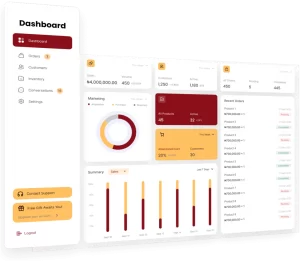Is your business’s financial performance stagnant or even declining? Have you made efforts to improve it but are still struggling to make progress?
Imagine this: your cash flow is strained, debts accumulate rapidly, and profits seem hard to achieve. If this situation sounds familiar, you are not alone. Poor financial management and analysis can hinder even the most promising businesses. However, there is a solution.
This article will guide you through 20 practical strategies to improve your business’s financial performance. From managing expenses more effectively to increasing revenue, these tips are designed to help you get your company back on track toward financial success.
Handa ka na bang pabilisin ang paglago ng iyong negosyo? Tuklasin natin ang mga estratehiyang ito at simulan nang pagbutihin ang iyong financial performance ngayong araw!
Table of Contents

Key Takeaways
|
Why Is It Important for Businesses to Improve Their Financial Performance?
Improving financial performance is essential for businesses for several key reasons. There are five main factors that highlight the importance of enhancing your company’s financial performance.
First, a strong financial foundation ensures long-term sustainability and growth. Companies with solid financial health are better positioned to withstand economic challenges, invest in innovation, and expand their market presence. Effective financial performance management can also enhance cash flow, reduce inefficiencies, and enable more informed decision-making, ultimately increasing profitability.
Second, demonstrating consistent financial success makes it easier to attract investors. Businesses that show signs of profitability and stability are more likely to secure funding from potential investors.
Additionally, better financial performance management can have a positive impact on employee morale. According to PwC’s 2023 Employee Financial Wellness Survey, 73% of financially stressed employees would consider switching employers if they found one that cared more about their financial well-being. Therefore, a financially stable company not only ensures its growth but also contributes to employee satisfaction and security.
Furthermore, customer trust and loyalty are often linked to a company’s financial reputation. Customers tend to engage with businesses they perceive as stable and reliable. According to RepTrak, a business’s financial performance accounts for 12.9% of its reputation, which can vary across different stakeholders, industries, and markets. In some regions, such as China, financial performance is considered one of the top concerns for businesses.
Finally, improving financial performance allows businesses to contribute to their communities through corporate social responsibility initiatives, creating a positive social impact beyond profits.
The following section will outline step by step strategies for improving your business’s financial performance and maintaining long-term financial health.
20 Effective Strategies to Enhance Your Business’s Financial Performance
Having established the importance of improving your financial performance, it’s now time to take action. Below are 20 practical strategies to help you turn financial challenges into opportunities. Ready to enhance your business’s financial performance? Let’s get started!
Stage 1: Foundation and planning
The foundation and planning stage is crucial for positioning your business for financial success. As a leader, it is essential to clearly define your objectives, understand your costs, and implement systems to track financial performance efficiently. Following these five steps, you can create a strong foundation supporting your business’s growth and adaptation over time.
1. Clarify and stay aligned with your business plan
Start by making sure your business plan is clearly defined and aligned with your financial goals. This plan should include your mission, vision, and specific financial targets.
For instance, if you aim to expand into a new market within the next year, your financial strategy should account for expenses such as marketing, hiring new staff, and developing products.
Keeping your business plan as your guide ensures your operations remain focused and that every financial decision contributes to achieving your long-term goals.
2. Know your day-to-day costs
Understanding your daily operational costs, including expenses such as employee wages and utility bills, is essential. For example, if you manage a small café with a daily operating cost of $500, you can set appropriate sales targets.
However, earning only $450 per day would signal the need to review expenses or explore strategies to boost revenue. The goal is to minimize these costs without compromising quality or service, ultimately improving profitability.
3. Monitor cash flow
Cash flow is vital for your business, so it’s important to monitor it closely. Make it a habit to track your income and expenses regularly. For example, a retail store needs to ensure that sales revenue is enough to cover inventory costs and other expenses.
A helpful tool is a cash flow statement, which shows money coming in, like sales, and going out, such as rent, utilities, and salaries.
4. Upgrade record-keeping with real-time data
Using outdated information can lead to unnecessary expenses and potential losses for your business. You can efficiently manage your financial records by adopting real-time data solutions, such as cloud-based Financial management systems.
For instance, an e-commerce business can use real-time data to track sales, update inventory, and monitor expenses instantly. This proactive approach enables quicker, well-informed decision-making, keeping you ahead of the competition.
Upgrading to real-time financial tracking is crucial for ensuring accurate performance insights. While manual methods can be time-consuming, finance ERP software like HashMicro simplifies the process by automating tasks and delivering real-time updates effortlessly.
Are you concerned about costs? Explore the pricing options—you may be surprised at how affordable smart financial management can be!
5. Choose the right metrics
Not all metrics hold the same value. Focusing on financial metrics that accurately represent your business’s health is important. For subscription-based businesses, key metrics include Customer Acquisition Cost (CAC) and Lifetime Value (LTV).
For example, if your CAC exceeds your LTV, it’s a warning sign that acquiring customers costs more than the revenue they generate.
Focusing on the right metrics can help you measure what truly matters, refining your strategy and achieving sustainable growth.
Stage 2: Expense management and cost efficiency
This stage aims to optimize business operations by identifying and eliminating unnecessary expenses. The objective is to enhance profitability by cutting costs without affecting the quality of your products or services. Efficient expense management helps maintain a strong cash flow and directs resources toward areas that drive growth. Here are four steps to achieve this:
6. Reduce expenses
To strengthen your business’s financial health, start by reviewing your spending. Separate your expenses into essential and non-essential categories.
Essential expenses include rent, utilities, and employee salaries, while non-essential costs might involve unused subscriptions or excessive travel. Reducing these unnecessary costs can significantly boost overall profitability over time.
7. Control overhead costs
Overhead costs, such as utilities, office supplies, and administrative fees, are essential expenses that keep your business running. To reduce utility bills, start by negotiating better rates with suppliers or switching to energy-efficient equipment.
For example, using energy-saving lighting or cloud-based software instead of expensive servers can lower costs. Regularly reviewing and adjusting these expenses in your financial performance statement is crucial for maintaining a lean operation.
HashMicro’s cloud-based finance reporting software makes managing these costs easier by helping you track and reduce expenses efficiently.
8. Sell unused/unwanted business assets
Over time, businesses accumulate unused assets, such as old office furniture, outdated technology, or excess inventory. Rather than letting these items sit idle, consider selling them to generate quick cash. For instance, sell the old ones on platforms if you’ve upgraded your office computers. This frees up space and provides extra funds that can be reinvested into your business.
9. Consolidate and reduce business debt
Debt can significantly burden your business, particularly when it carries high interest rates. As Henry Wheeler Shaw (also known as Josh Billings) wisely said, “Debt is like any other trap, easy enough to get into, but hard enough to get out of.”
To manage this, consider consolidating multiple debts into one loan with a lower interest rate. This can simplify repayment and reduce costs.
Stage 3: Revenue optimization
This stage maximizes revenue by optimizing pricing strategies, boosting sales conversion rates, and expanding the customer base. Businesses can achieve sustainable growth, enhance profitability, and strengthen their market position by strategically managing these areas. Here are the five steps in this stage:
10. Improve account receivable collection
Effectively managing your accounts receivable is essential for maintaining a healthy cash flow. Begin by setting clear payment terms and communicating them to customers from the start. Use automated reminders for upcoming due dates and follow up promptly on overdue invoices. This approach helps shorten the gap between sales and payment receipt, ensuring your business remains financially stable.
11. Revise your offer and pricing
Regularly reviewing and adjusting your pricing strategy is essential for remaining competitive. Start by analyzing your cost structure, market demand, and competitor pricing. If your sales have stagnated, evaluate whether your prices accurately reflect your offer’s value.
12. Boost the conversion rate
Focus on improving the customer experience to increase the number of leads who become paying customers. This can include refining your sales pitch, making your website easier to navigate, or personalizing your marketing efforts.
For example, if your website has a high bounce rate, try simplifying the navigation or adding a live chat feature to help visitors instantly.
13. Offer multiple payment options
Offering a variety of payment methods can greatly improve the customer experience and remove obstacles to making a purchase. For instance, if you only accept credit cards, you may lose customers who prefer digital wallets or bank transfers.
By adding options such as PayPal, Apple Pay, PayNow, PayLah, NETS, and others. You can reach a wider audience and make it easier for customers to complete their transactions. This approach not only increases sales but also fosters customer trust and satisfaction.
14. Expand your customer base
Expanding your market and reaching new customer segments is key to long-term growth. Identify untapped markets or demographics that could benefit from your product or service.
You can also use social media and online advertising to target specific groups based on interests, behaviors, and location. By broadening your customer base, you can increase sales and reduce the risk of relying on a narrow market.
Stage 4: Financial strategy and investment
This stage, which includes three steps, focuses on securing and managing the financial resources necessary to support your business’s growth. As Suze Orman wisely said, “the key to making money is to stay invested.”
Whether through business financing, external investments, or flexible funding options, the aim is to ensure your business has the financial strength to capitalize on opportunities, overcome challenges, and maintain steady cash flow.
15. Apply for business financing
Business financing is crucial for driving growth, whether launching a new product or expanding operations. Begin by assessing your needs: do you require a short-term loan to manage cash flow or a long-term loan for capital investment?
For instance, California is home to a thriving small business ecosystem, making access to tailored funding options essential for success. Entrepreneurs in the state can explore programs offered by California SBA lenders, who specialize in supporting local enterprises.
Prepare a strong business plan and financial projections to demonstrate your ability to repay the loan and gain lenders’ confidence.
16. Consider external investment
External investment can provide your business with capital, expertise, and valuable connections. It’s like hiring a co-pilot to help navigate challenges.
For example, a tech startup might approach a venture capital firm with expertise in their field, offering both funding and strategic support. Since investors expect a return, be ready to share both the rewards and risks.
17. Transition to flexible financing structures
Flexible financing options enable your business to adjust to changing circumstances without being trapped in financial difficulties.
This could include a combination of equity and debt financing or revolving credit lines that offer more flexibility during slow revenue periods.
For example, a retail company might use a revolving credit line to manage seasonal variations in inventory purchases. This strategy ensures you avoid excessive debt while still having the funds for growth.
Stage 5: Advanced financial management
This stage focuses on refining your financial strategies through advanced tools and techniques. The aim is to improve decision-making, reduce risks, and increase profitability by leveraging technology, thorough analysis, and strategic alignment.
This phase ensures your business survives and thrives in a competitive market. Here are the final three steps to take in this stage:
18. Use FP&A software
Implementing Financial Planning & Analysis (FP&A) software helps you accurately predict, budget and manage finances. For example, retail businesses can use FP&A software to predict seasonal sales trends based on past data, enabling better resource allocation.
The software provides detailed reports and dashboards, so you can make informed decisions, identify trends early, and address financial challenges effectively.
FP&A software can significantly improve financial performance, and when it comes to the best solutions in the Philippines, HashMicro is the best. Its financial ERP software is designed with local business needs in mind, making it an essential tool.
19. Critically examine your supply chain
Analyzing your supply chain is essential for cutting costs and boosting efficiency. For example, a manufacturer that sources materials from multiple suppliers could find that consolidating orders with a single supplier helps lower shipping costs and speeds up delivery times. Moreover, adopting a just-in-time inventory system can reduce storage costs and minimize waste.
20. Align risk management and compliance
Risk management and compliance act as safety nets for your financial strategy. Ensuring your business follows regulations while managing financial risks helps avoid costly penalties and disruptions.
For example, a financial institution must comply with anti-money laundering laws. By aligning their risk management with compliance, they can prevent significant fines and safeguard their reputation.
Enhance Your Business’s Financial Performance with HashMicro’s Accounting Software
HashMicro’s finance ERP software is the top choice in the Philippines for enhancing financial performance. Its advanced features, customized for local businesses, provide real-time insights, streamline processes, and ensure compliance, making the financial management system more efficient and effective.
You can try HashMicro’s software through a free demo, allowing you to experience its benefits with no commitment. See how it can simplify your financial planning and analysis, making your business operations smoother than ever.
HashMicro’s finance ERP software includes a user-friendly financial dashboard that simplifies profit tracking per contract, manages asset depreciation effortlessly, and streamlines budgeting.
With tools for accrual and amortization calculations, cash flow forecasting, and precise financial reporting, it’s like having a financial expert at your service—without a high salary.
Here are the key features of HashMicro’s accounting software that can boost your business’s financial performance:
- Financial dashboard: It gives you a real-time overview of your finances, allowing quick monitoring of key metrics and enabling faster, informed decisions.
- Cash flow forecasting: Accurately predicts cash flows, helping you plan for shortfalls or surpluses, ensuring better resource allocation and financial stability.
- Fast bank reconciliation: Automates bank transaction reconciliation, saving time and reducing errors while keeping accounts accurate and up-to-date for enhanced financial trustworthiness.
- Accrual and amortization: Ensures accurate recognition of expenses and revenue, aligning with accounting standards and reflecting your business’s proper financial health.
- E-invoicing: Facilitates secure electronic invoicing, speeding up payment cycles and boosting cash flow by reducing manual processes and accounts receivable days.
- Analytical reporting: Generates detailed financial reports, offering insights into performance trends and areas for improvement, driving more intelligent decisions and better profitability.

Conclusion
Enhancing your business’s financial performance is no longer optional—it’s essential. Relying on outdated methods can put you at a disadvantage. Adopting modern, advanced accounting software is vital for accurate financial planning and analysis (FP&A).
HashMicro’s finance ERP software offers powerful tools that deliver real-time insights, streamline workflows, and empower you to make more informed financial decisions. Don’t wait for financial issues to become overwhelming—take control now with the right technology.
Interested in seeing how HashMicro can transform your financial management? Try the free demo today and discover how our software can elevate your business.
With HashMicro, you’ll have the tools to manage the complexities of financial planning with ease and confidence. Start improving your financial performance today!

Frequently Asked Questions About Financial Performance
-
How is financial performance measured?
Common metrics include revenue, profit margins, return on investment (ROI), and cash flow analysis.
-
How do financial reports reflect performance?
Financial reports summarize key indicators like income, expenses, assets, and liabilities to show overall performance.
-
How is financial performance linked to business strategy?
Strong strategies align goals with performance, driving growth and sustainability in business strategy.
{
“@context”: “https://schema.org”,
“@type”: “FAQPage”,
“mainEntity”: [{
“@type”: “Question”,
“name”: “How is financial performance measured?Common metrics include revenue, profit margins, return on investment (ROI), and cash flow analysis.”,
“acceptedAnswer”: {
“@type”: “Answer”,
“text”: “Common metrics include revenue, profit margins, return on investment (ROI), and cash flow analysis.”
}
},{
“@type”: “Question”,
“name”: “How do financial reports reflect performance?”,
“acceptedAnswer”: {
“@type”: “Answer”,
“text”: “Financial reports summarize key indicators like income, expenses, assets, and liabilities to show overall performance.”
}
},{
“@type”: “Question”,
“name”: “How is financial performance linked to business strategy?”,
“acceptedAnswer”: {
“@type”: “Answer”,
“text”: “Strong strategies align goals with performance, driving growth and sustainability.”
}
}]
}






















